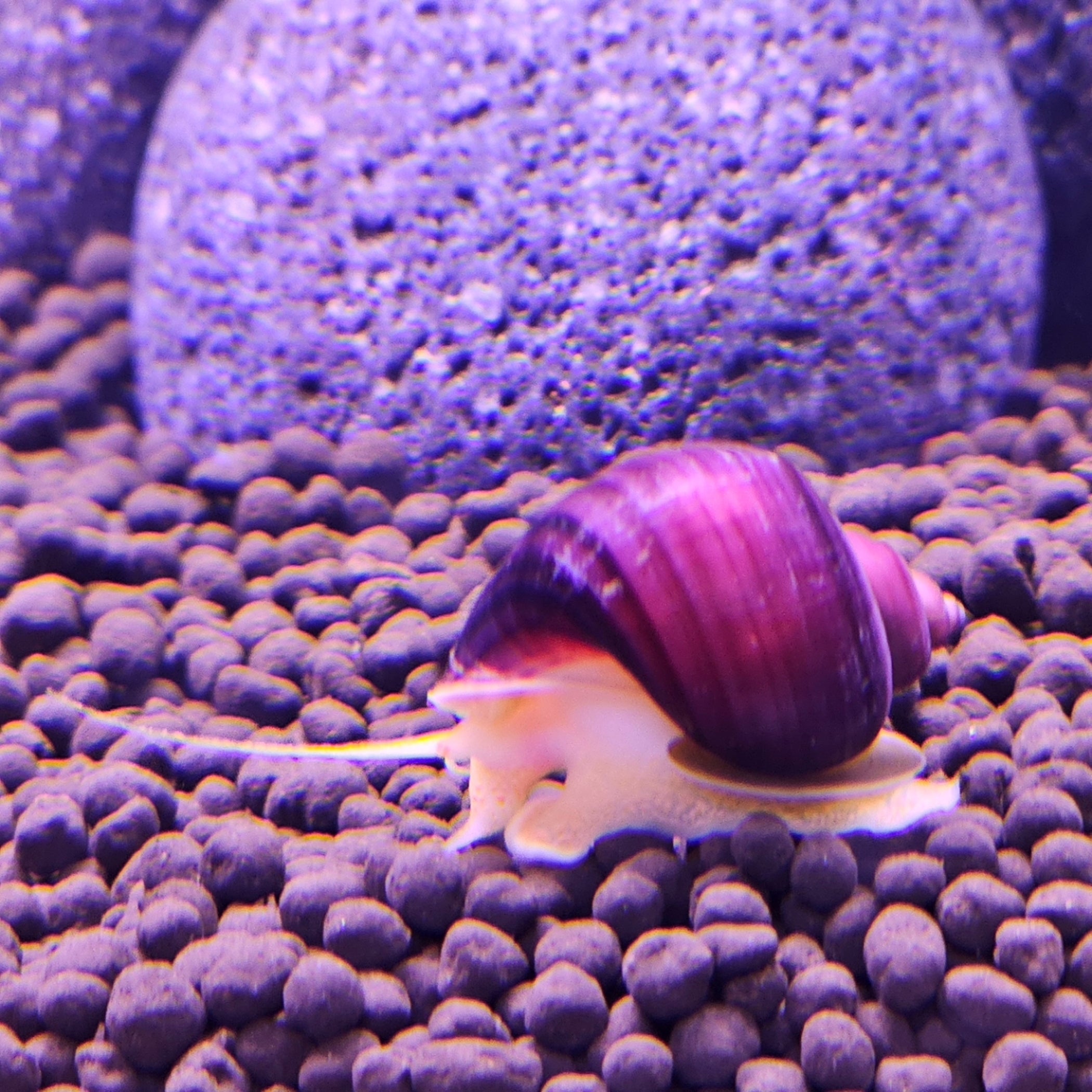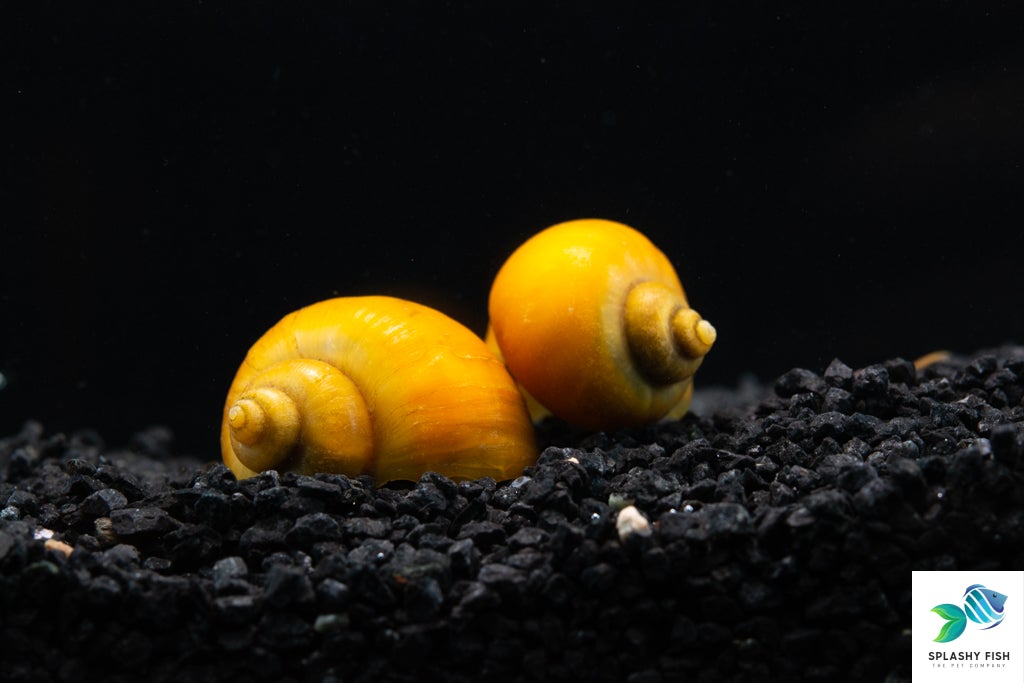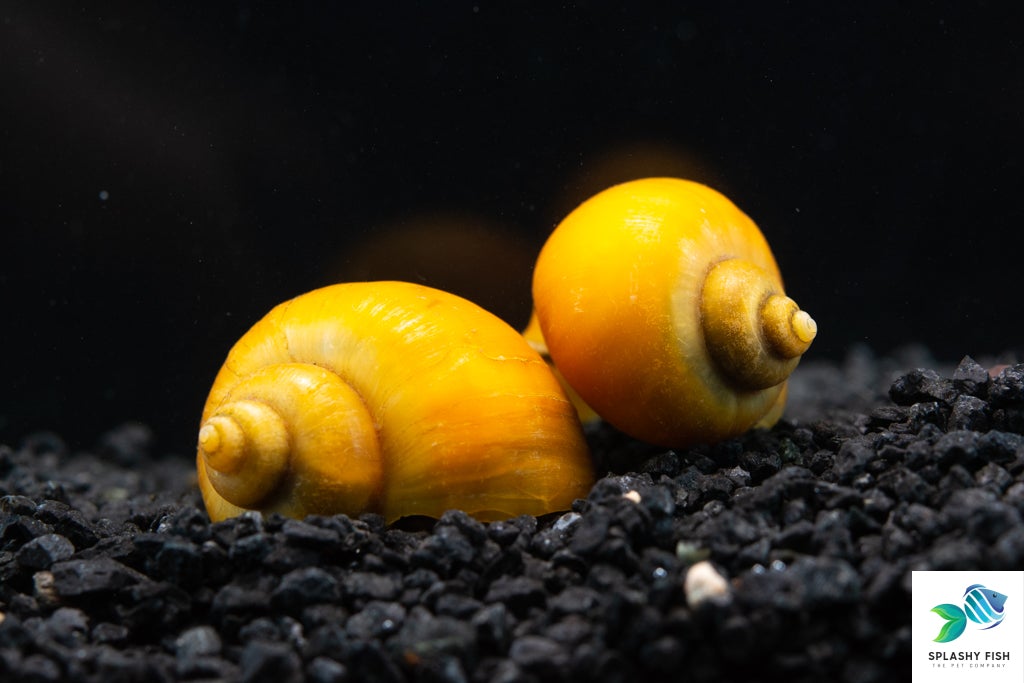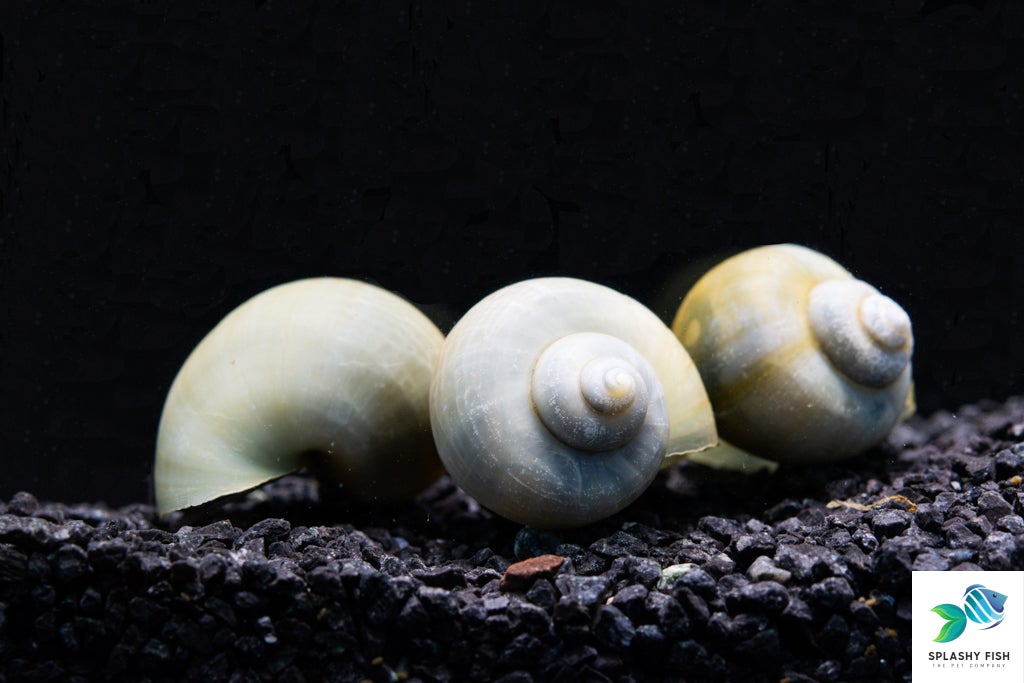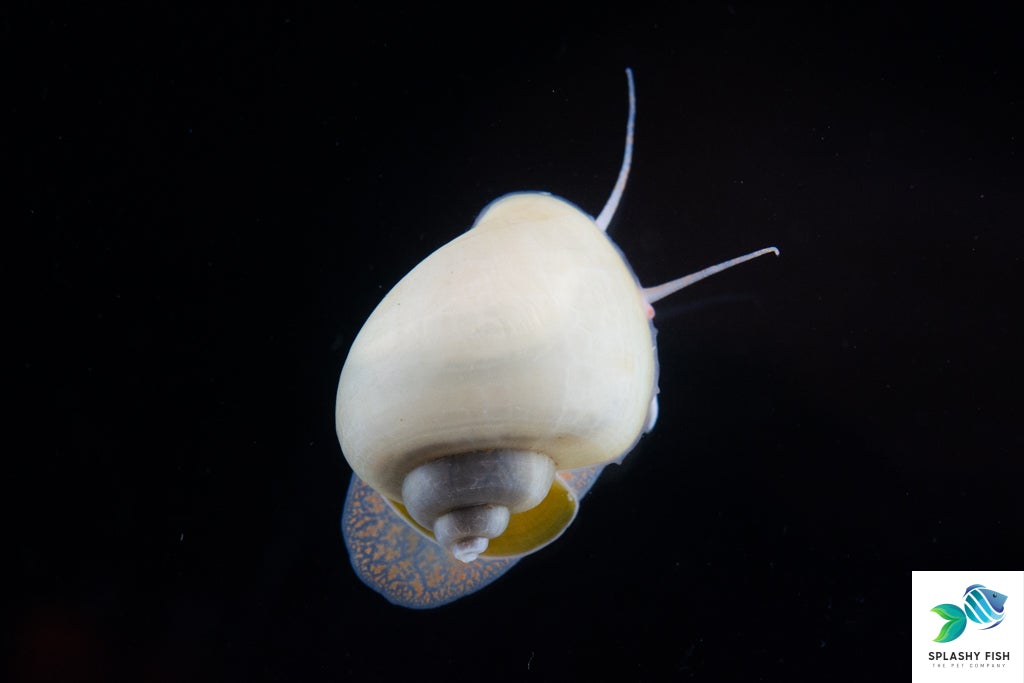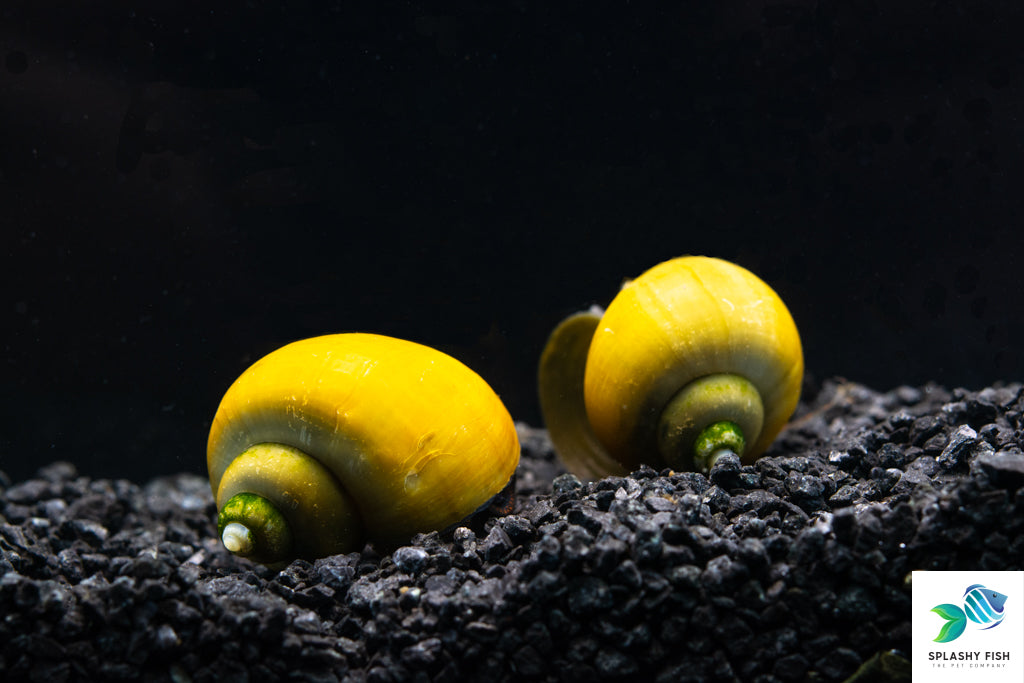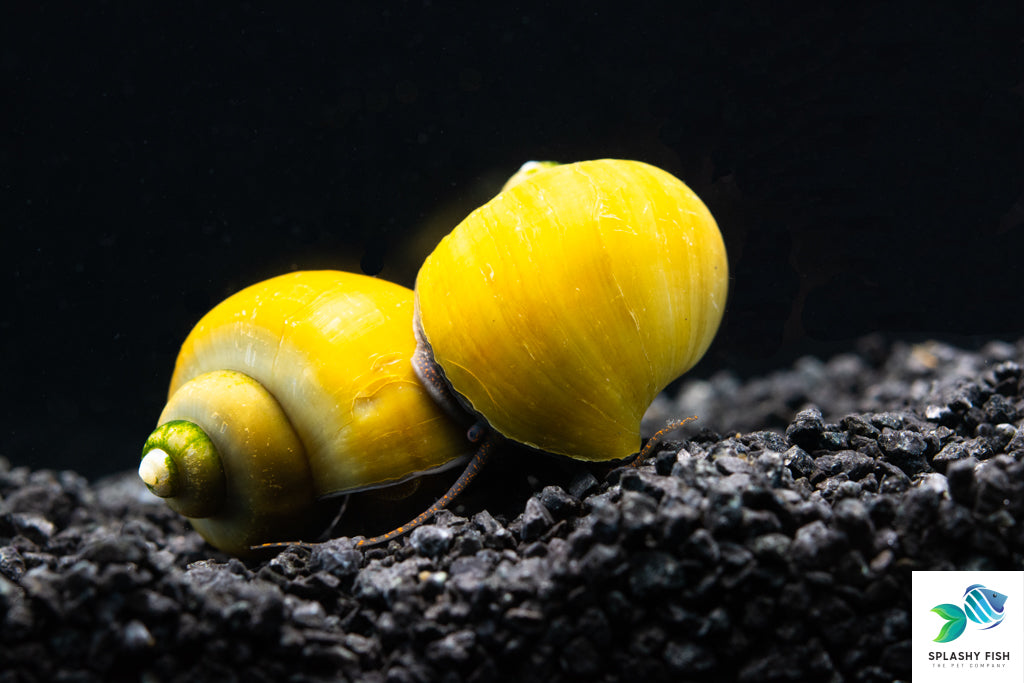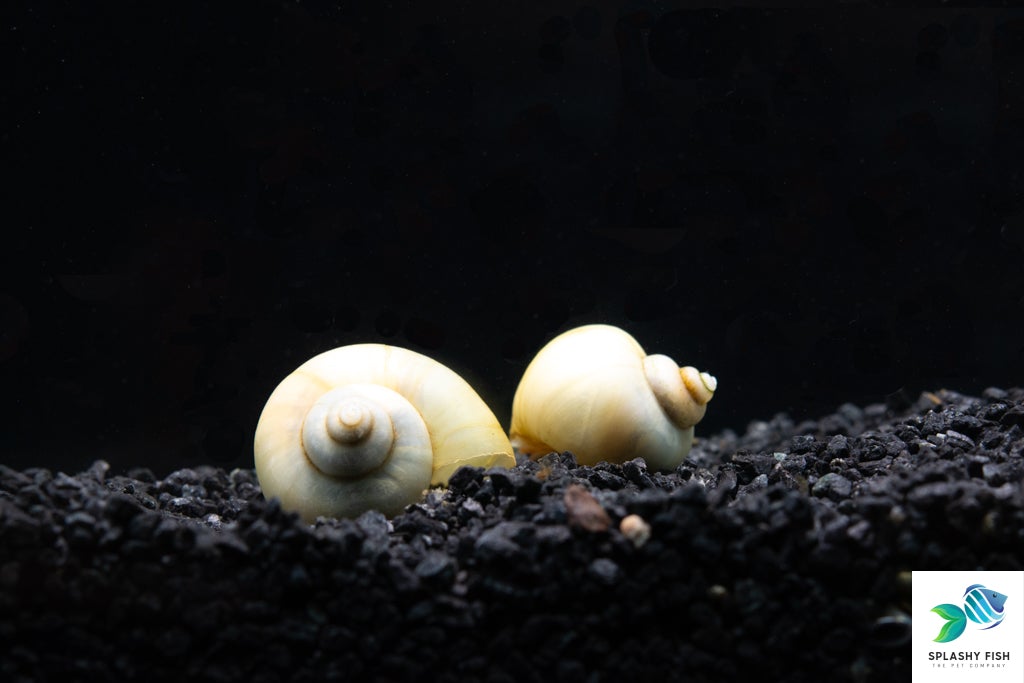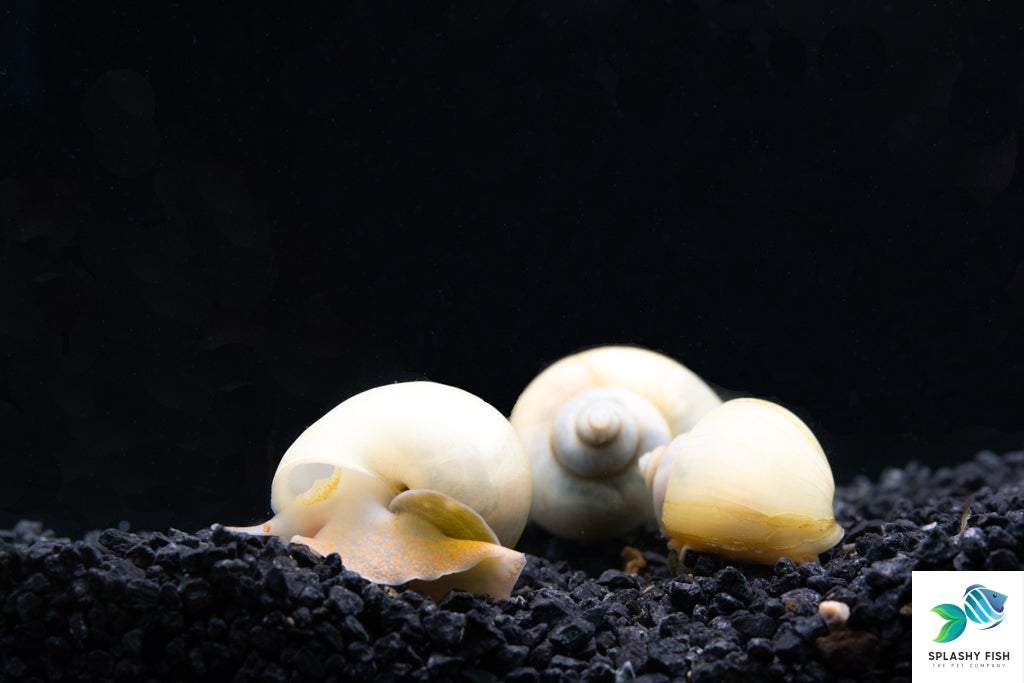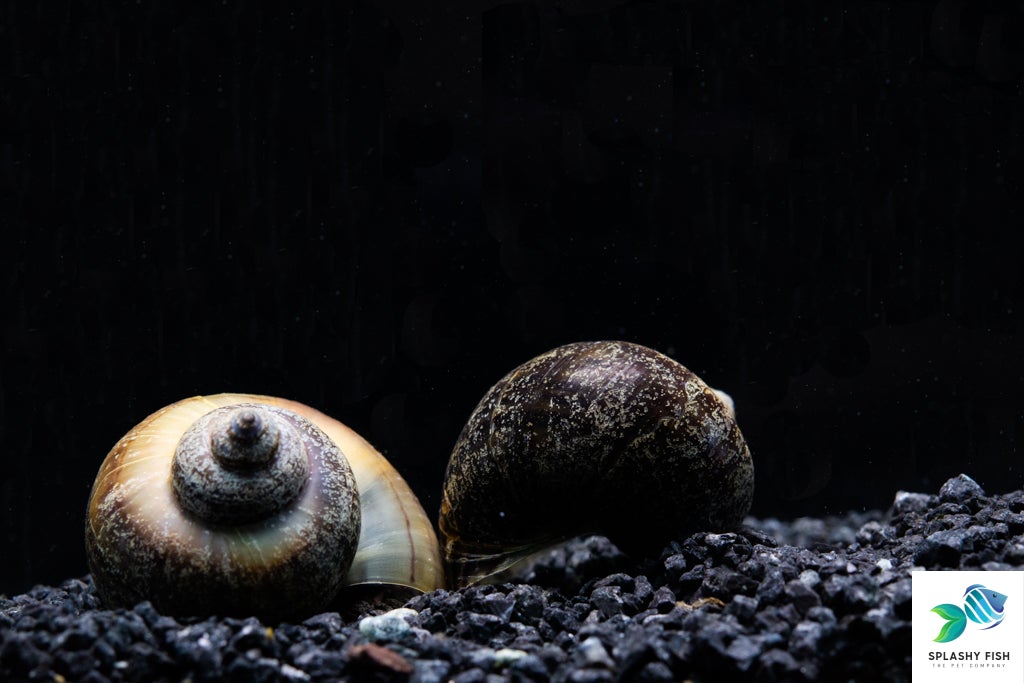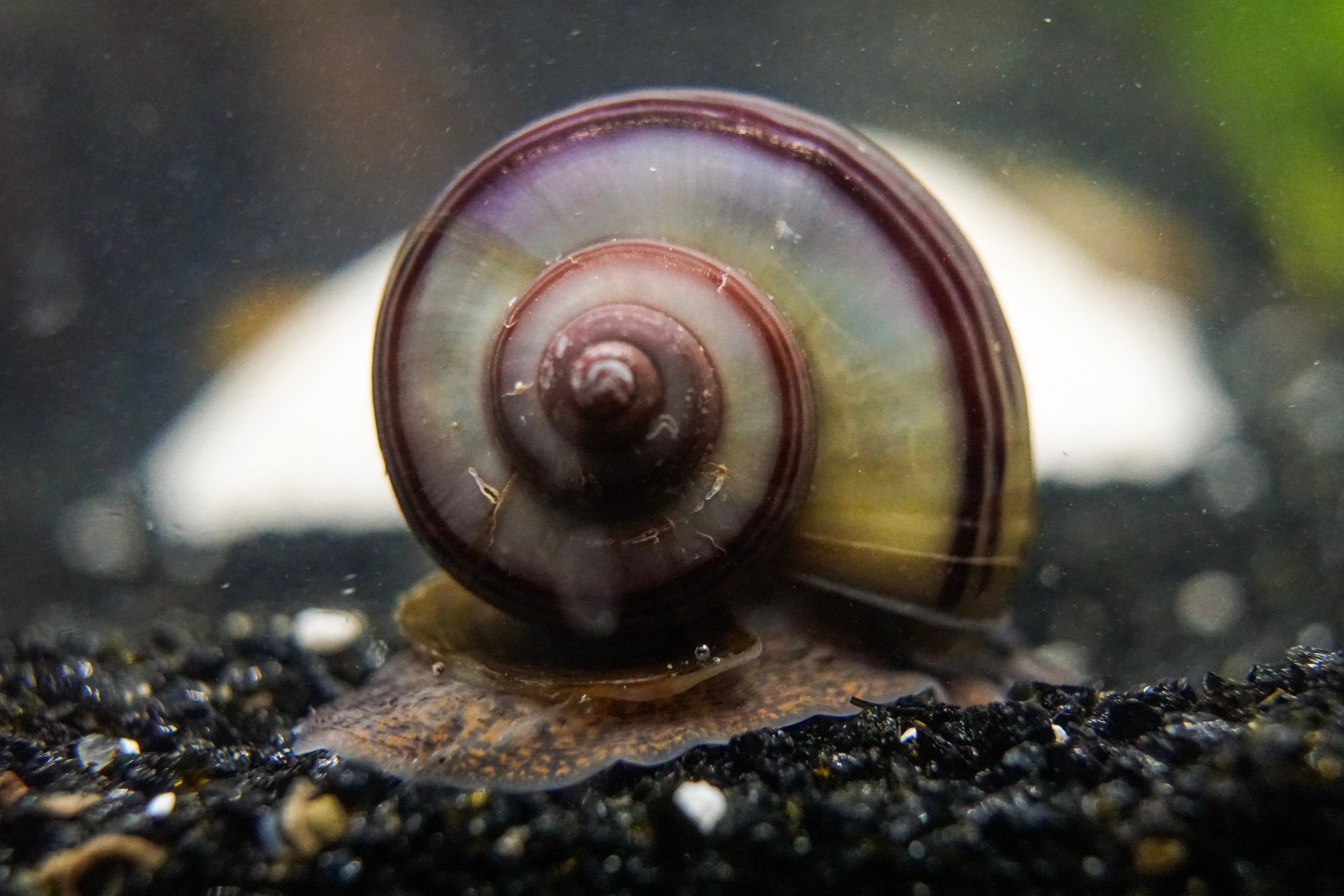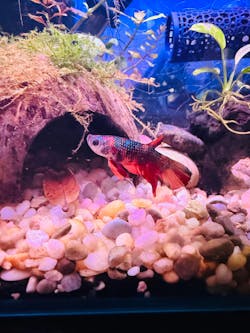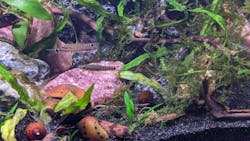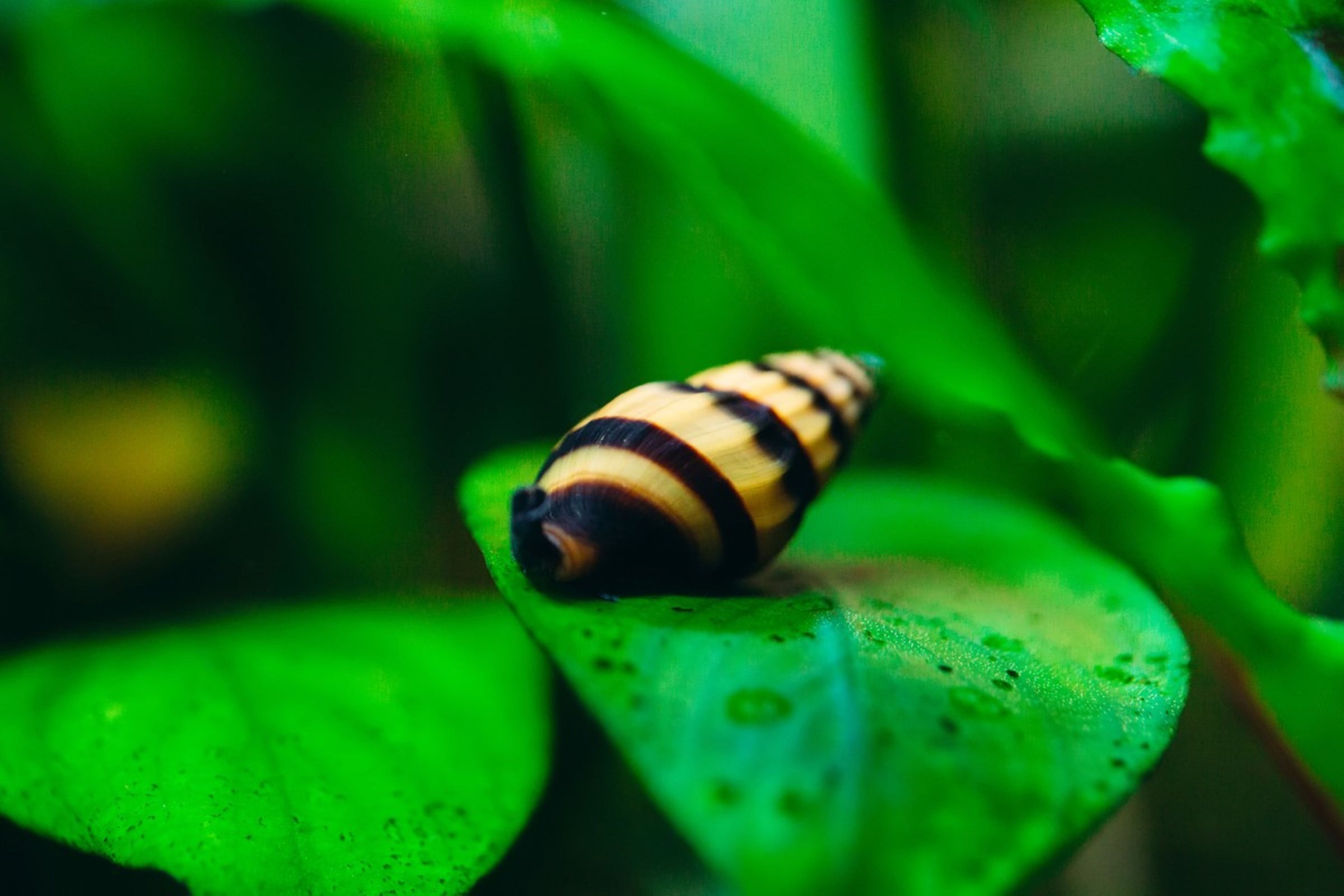
Freshwater Snails
Why Choose Freshwater Snails for Your Aquarium?
Freshwater snails offer numerous benefits for your aquarium. They come in various shapes, sizes, and colors, adding a unique aesthetic appeal to your tank. Many snail species are excellent algae eaters, helping to keep your aquarium crystal clear. Additionally, snails efficiently consume leftover fish food and decaying plant matter, improving water quality. Most freshwater snails are peaceful and compatible with a wide range of fish species.
Popular Freshwater Snail Species
Several popular freshwater snail species can enhance your aquarium.
Mystery snails are known for their algae-eating abilities and striking appearance, coming in various colors like blue, gold, and pink. At Splashy Fish, we offer a wide range of colors for these types of shrimp including Blue Mystery Snails, Ivory Mystery Snails, Gold Mystery Snails, Crystal Red Shrimp and many more.
Nerite snails, with their hard shells and vibrant patterns, are excellent algae eaters, particularly effective against stubborn hair algae. Some popular Nerite Snails species that are available at our store are Zebra Nerite Snails, Tiger Nerite Snails, Red Racer Nerite Snails, and many more.
Small and disk-shaped, Ramshorn snails are prolific breeders and efficient algae scavengers, available in brown, gold, and pink varieties. They are great for keeping your tank clean and are a popular choice for beginners.
Carnivorous and specifically targeting other snails, Assassin snails are useful for controlling snail populations in aquariums. They are often used to eliminate unwanted snail species, such as bladder snails.
Tips for Keeping Freshwater Snails
To ensure the health and well-being of your freshwater snails, maintain clean, well-oxygenated water with appropriate pH levels. While snails primarily feed on algae and detritus, you can supplement their diet with algae wafers or blanched vegetables once or twice a week.
Choose peaceful freshwater fish that won't harass or harm your snails. Good tank mates include tetras, danios, guppies, mollies, platies, and corydoras. Avoid aggressive fish like cichlids, large catfish, and large loaches.
Many snail species reproduce easily in aquarium conditions, so be prepared for an increase in population. If you find that your snail population is getting too large, you can manually remove some of the snails or introduce Assassin snails to help control the population.
Freshwater Snails for Sale Online
At Splashy Fish tropical fish store, we offer a wide selection of high-quality freshwater snails for sale online such as Mystery snails for sale, Nerite snails for sale, Ramshorn snails for sale, and Assassin snails for sale. Our snails are carefully sourced and shipped to ensure they arrive healthy and ready to thrive in your aquarium. Visit our website to buy them online or at our aquarium store in Virginia for other aquarium products.
Freshwater Snails Frequently Asked Questions FAQs
What do freshwater snails eat?
Freshwater snails are primarily herbivores, feeding on algae, detritus, and decaying plant matter. They play a crucial role in maintaining a clean and balanced aquarium ecosystem by consuming excess algae and organic debris.
How often should I feed my freshwater snails?
While snails primarily feed on algae and detritus, you can supplement their diet with algae wafers or blanched vegetables once or twice a week.
Can freshwater snails live with fish?
Yes, many freshwater snail species are peaceful and compatible with a variety of fish species such as Tetras, Guppy, Cichlids, Corydoras, etc. However, it's important to avoid aggressive fish that may harm the snails.
The Comprehensive Guide to Freshwater Snails: Advanced Care Techniques
Welcome to the ultimate freshwater snail care guide! In this article, we will provide you with everything you need to know for advanced care techniques. From choosing the right species to creating the optimum environment, we've got you covered. Maintaining happy and healthy freshwater snails in your aquarium requires proper understanding and care. In this guide, we'll delve into the key factors contributing to these fascinating creatures' well-being. You'll learn about their habitat requirements, feeding habits, water parameters, and even potential health issues to watch out for. We aim to equip you with the knowledge and techniques to create the perfect home for your freshwater snails. By implementing these advanced care strategies, you can ensure your snails thrive and flourish in their aquatic paradise. So, whether you're fascinated by the extraordinary beauty of mystery snails, or you're intrigued by the intricate patterns of zebra nerite snails, join us as we dive into the world of freshwater snails and become a master in their care.
Freshwater Snails Origin
Welcome to the ultimate freshwater snail care guide! In this article, we will provide you with everything you need to know for advanced care techniques. From choosing the right species to creating the optimum environment, we've got you covered. Maintaining happy and healthy freshwater snails in your aquarium requires proper understanding and care. In this guide, we'll delve into the key factors contributing to these fascinating creatures' well-being. You'll learn about their habitat requirements, feeding habits, water parameters, and even potential health issues to watch out for. We aim to equip you with the knowledge and techniques to create the perfect home for your freshwater snails. By implementing these advanced care strategies, you can ensure your snails thrive and flourish in their aquatic paradise. So, whether you're fascinated by the extraordinary beauty of mystery snails, or you're intrigued by the intricate patterns of zebra nerite snails, join us as we dive into the world of freshwater snails and become a master in their care.
Freshwater Snails Origin
Freshwater snails are native to diverse habitats around the globe, from lush rivers and lakes to tranquil ponds. These aquatic environments provide varying conditions that shape each species' unique traits and preferences, making it essential to understand their origins when setting up an aquarium.
Popular species such as Zebra Nerite Snails (Neritina natalensis) come from regions across Africa, thriving in streams and rivers. In contrast, mystery snails (Pomacea diffusa) hail from South American waters, known for their resilience and range of colors.
Many freshwater snails have adapted to different environments, which allows them to adjust to aquarium life but still requires careful management of tank conditions to mimic their natural habitats.
Why Should You Add Freshwater Snails in Your Aquarium?
Freshwater snails bring several benefits to aquariums beyond their aesthetic appeal. Here are some compelling reasons why these gentle tank cleaners are a valuable addition:
- Natural Algae Control: Many snail species, including Nerite snails, are natural algae eaters, keeping your tank clean without the need for harsh chemicals.
- Substrate Aeration: As snails burrow and explore, they aerate the aquarium substrate, reducing gas buildup and promoting a healthier environment for live plants and fish.
- Eco-Balanced Aquarium: Aquarium snails add to your tank's biodiversity, contributing to a balanced ecosystem that enhances overall water quality and aesthetic appeal.
Popular Types of Freshwater Snails
Aquarium snails come in many varieties, each with unique characteristics and care requirements. Here are some of the most popular species for home aquariums, along with details on their behaviors, specific needs, and benefits to the tank:
Mystery Snails (Pomacea bridgesii)
- Appearance: Available in colors like golden, blue, purple, and ivory, with distinctive swirls on their shells.
- Size: Grow up to 2 inches in diameter.
- Care Requirements: Mystery snails are hardy and adaptable, thriving in water pH levels between 7.0-8.0 and temperatures around 68°F-82°F. They are non-invasive and won’t overpopulate your tank.
- Behavior and Benefits: Mystery snails are peaceful and excellent algae eaters, making them perfect tank cleaners. They’re known for their inquisitive nature and occasionally climb out of the water, so be sure your tank is covered.
Nerite Snails (Neritina spp.)
- Appearance: Known for their beautifully patterned shells, including zebra stripes, tiger patterns, and spotted varieties.
- Size: Usually around 1 inch in diameter.
- Care Requirements: Nerite snails require slightly alkaline water (pH 7.5-8.5) and temperatures of 72°F-78°F. Unlike some other snails, they cannot reproduce in freshwater, which prevents overpopulation.
- Behavior and Benefits: Nerites are fantastic algae-eaters and will scour every surface of the snail tank, keeping it spotless. They are peaceful and perfect for community tanks.
Ramshorn Snails (Planorbidae family)
- Appearance: Spiral-shaped shells with colors ranging from red and brown to blue.
- Size: Typically smaller, growing up to 1 inch.
- Care Requirements: Ramshorn snails are tolerant of a wide range of conditions, with a pH of 7.0-8.0 and temperatures between 70°F-78°F. They do reproduce quickly, so it’s wise to monitor their population.
- Behavior and Benefits: These snails feed on algae, dead plant material, and leftover fish food, helping to reduce waste. However, they may nibble on live aquatic plants if food is scarce.
Assassin Snails (Clea helena)
- Appearance: Beautiful yellow and black striped shells, which give them a striking look.
- Size: Reach up to 1.5 inches.
- Care Requirements: Assassins prefer a pH of 7.0-8.0 and temperatures around 75°F-80°F. They are carnivorous and require protein-rich foods if not hunting.
- Behavior and Benefits: Assassin snails are natural pest controllers, preying on other snail species like pond and bladder snails. They are peaceful with freshwater fish but highly effective at controlling snail overpopulation.
Malaysian Trumpet Snails (Melanoides tuberculata)
- Appearance: Cone-shaped shells that come in brown or spotted patterns.
- Size: Generally grow up to 1 inch.
- Care Requirements: These snails thrive in a wide range of conditions, with a pH of 7.0-8.0 and temperatures from 70°F-80°F.
- Behavior and Benefits: Malaysian trumpet snails are nocturnal and burrow in the substrate, preventing it from compacting and improving oxygen circulation. They can reproduce quickly, so population control may be necessary.
Advanced Care Techniques for Freshwater Snails
Tank Setup
Tank Size
Freshwater snails are relatively small, but even a small tank should provide ample room to prevent overcrowding and allow them to explore. For most species, a 5-gallon tank is the minimum.
Substrate
A fine sand or gravel substrate is ideal for snails, as it’s gentle on their soft bodies and allows them to burrow naturally.
Filtration and Aeration
Aquarium snails prefer oxygenated water with a moderate flow rate, so invest in a reliable filtration system that maintains water cleanliness without creating excessive currents.
Water Parameters
Maintaining stable water conditions is crucial for snail health, as they are sensitive to fluctuations.
pH Levels
Most freshwater snails thrive in a pH range of 7.0-8.0. This slightly alkaline environment supports healthy shell development and prevents shell erosion, a common problem in softer, more acidic water.
Water Hardness
Calcium is essential for snails’ shell health. Maintain a hardness level of 7-12 dGH to ensure a steady calcium supply. Adding calcium supplements or using a crushed coral substrate can help increase hardness if needed.
Ammonia, Nitrite, and Nitrate Levels
Ammonia and nitrite levels should be kept at 0 ppm, while nitrate levels should remain below 20 ppm. High toxin levels can stress or even kill snails, so regular water changes are vital.
Temperature
Snails prefer a temperature range that is suitable for tropical fish, typically between 72°F and 78°F (22°C - 26°C). Certain species, like nerite snails, can tolerate slightly cooler temperatures, but most will thrive in this range. Avoid sudden temperature fluctuations by placing the tank away from direct sunlight or air vents.
Feeding and Nutrition
A well-balanced diet keeps snails active and healthy. Here’s how to meet their nutritional needs:
- Natural Algae: Algae is a primary food source for many snails, particularly nerite snails. If your tank has insufficient algae, supplement their diet with algae wafers.
- Blanched Vegetables: Snails enjoy blanched zucchini, cucumber, and spinach. Place a small piece in the tank, and remove any uneaten portions after a few hours to prevent water contamination.
- Calcium Supplements: To support shell growth, add calcium-rich foods like cuttlebone, crushed eggshells, or calcium blocks. These supplements ensure their shells remain strong and resistant to wear.
Common Health Issues and How to Prevent Freshwater Snails
Freshwater snails are resilient but still susceptible to certain health issues. Here’s what to watch for and how to prevent common problems:
- Shell Erosion and Pitting: Often caused by low calcium or acidic water, shell erosion appears as pits or cracks. Regularly check water parameters and add calcium supplements to prevent this issue.
- Parasitic Infections: Some snails may carry parasites, which can affect other tank inhabitants. Quarantine new snails for a few weeks before adding them to a community tank.
- Lethargy and Inactivity: If your snail is less active, it might be due to poor water quality or an unsuitable diet. Regular water changes, coupled with a nutrient-rich diet, will generally resolve this issue.
Breeding Freshwater Snails
Some freshwater snails breed readily, while others, like nerite snails, require brackish water for their eggs to hatch. Here’s an overview of the breeding process for a few popular species:
- Mystery Snails: Mystery snails lay eggs above the waterline, forming a cluster. After a few weeks, the eggs hatch, and baby snails drop into the water.
- Ramshorn Snails: Ramshorns lay gelatinous egg clusters on plants and tank decorations. They can quickly overpopulate, so consider a separate tank if you plan to breed them.
- Nerite Snails: Nerites require brackish water for their eggs to hatch. While they may lay eggs in a freshwater tank, they will not hatch without the proper saline environment.
What Are The Best Tank Mates for Freshwater Snails?
Selecting compatible tank mates is essential to ensure a peaceful, balanced environment where your snails and fish can thrive together. Here are some excellent tank mate choices for freshwater snails, along with specific details on compatibility:
Small, Peaceful Fish
- Examples: Guppies, Tetras (Neon tetras, Cardinal tetras), and Rasboras.
- Compatibility: These live fish are small, gentle, and unlikely to bother snails. They share similar water parameters and won’t compete with snails for food.
- Benefits: These fish add vibrant color and activity to the tank, complementing the calming presence of snails.
Shrimp Species
- Examples: Amano shrimp, Neocaridina shrimp, and Ghost shrimp.
- Compatibility: Shrimp are peaceful and share a similar diet with snails, often feeding on algae and detritus. Both species can happily coexist and benefit from the same water parameters.
- Benefits: Shrimp help maintain the tank’s cleanliness by consuming algae and uneaten food, enhancing the tank's ecosystem.
Bottom-Dwelling Catfish
- Examples: Corydoras catfish and Otocinclus catfish.
- Compatibility: These catfish are non-aggressive and will leave snails alone. They also help clean the substrate, making them an ideal match for snails that prefer clean surfaces.
- Benefits: Corydoras and Otocinclus contribute to the tank's maintenance by eating leftover food, reducing the chance of organic waste accumulation.
Other Non-Aggressive Snail Species
- Examples: Different species of Nerite snails, Mystery snails, and Malaysian trumpet snails.
- Compatibility: Most freshwater snail species are peaceful and won’t bother each other. Housing multiple types of snails can create a diverse and visually interesting tank.
- Benefits: Different snail species contribute to various cleaning roles, such as algae removal, substrate aeration, and leftover food consumption.
Tank Mates to Avoid
Avoid adding aggressive fish like Cichlids, Loaches (especially Clown loaches), and some Gouramis. These fish may attack snails, potentially injuring or killing them. Betta fish can be hit or miss; while some bettas ignore snails, others may nip at them.
Live Plants for Freshwater Snails
Live plants not only beautify your aquarium but also provide a healthy environment for snails by offering additional food sources and hiding spots. Here are some ideal plants for snail-friendly tanks:
Amazon Sword (Echinodorus bleheri)
- Growth: Moderate to fast-growing, with long, sword-shaped leaves.
- Care Requirements: Prefers moderate to high light and nutrient-rich substrates. Amazon Sword can be planted in the substrate or allowed to float.
- Benefits for Snails: The dense root system provides hiding spots and a source of biofilm, a food source for many snails. Additionally, the broad leaves can offer surfaces for algae growth.
Java Fern (Microsorum pteropus)
- Growth: Slow-growing, with broad, sturdy leaves.
- Care Requirements: Java ferns are low-maintenance and thrive in low to moderate light. They attach easily to rocks or driftwood.
- Benefits for Snails: The broad leaves offer surfaces for algae growth, which snails can feed on, while the structure provides hiding spots and reduces stress.
Anubias (Anubias spp.)
- Growth: Hardy, low-light plant with thick, dark green leaves.
- Care Requirements: Anubias is resilient and grows slowly, making it ideal for a low-maintenance setup.
- Benefits for Snails: Anubias plant is resistant to grazing, so snails can feed on the biofilm and algae on the leaves without damaging the plant. It provides excellent cover and can be easily placed around the tank.
Cryptocoryne (Cryptocoryne spp.)
- Growth: Moderate growth rate with broad, green leaves that vary in size and shape.
- Care Requirements: Prefers moderate lighting and grows well in slightly acidic to neutral pH levels.
- Benefits for Snails: Cryptocoryne provides ample cover for snails and has leaves that allow for algae and biofilm growth. Snails find a sense of security around these plants.
Java Moss (Taxiphyllum barbieri)
- Growth: Fast-growing and can form a carpet over rocks, driftwood, or the tank bottom.
- Care Requirements: Tolerates low to high light and does well in a wide range of water conditions.
- Benefits for Snails: Java moss is perfect for snails to hide in and graze on. It can also house microfauna and biofilm, offering additional natural food sources for your snails.
Water Wisteria (Hygrophila difformis)
- Growth: Fast-growing, with feathery leaves that create a lush environment.
- Care Requirements: Thrives in moderate to high light and benefits from nutrient-rich substrates.
- Benefits for Snails: Water wisteria creates dense foliage, ideal for snails to explore and hide. Its fast growth can help maintain water quality by absorbing excess nutrients.
Vallisneria (Vallisneria spp.)
- Growth: Produces long, ribbon-like leaves that sway with water movement.
- Care Requirements: Grows best in moderate lighting and can adapt to various water conditions.
- Benefits for Snails: Vallisneria provides tall, natural cover, allowing snails to retreat and avoid stress. Algae often grow on the leaves, providing a natural food source.
Enhance The Freshwater Snails Tank with Aquarium Decoration
Incorporating the right decorations can enhance both the beauty of your tank and the comfort of your snails. Here are some decoration tips for a snail-friendly setup:
- Caves and Driftwood: Snails enjoy exploring, and caves or aquarium driftwood provide secure hiding spots. Driftwood can also encourage biofilm growth, which many snails enjoy.
- Smooth Rocks: Smooth, algae-covered aquarium rocks offer additional feeding areas for algae-loving snails and prevent injuries to their soft bodies.
- Aquascaping: Creating gentle hills or valleys in the substrate gives snails more space to explore and exercise.
Ensure that any aquarium decorations are free of sharp edges and are aquarium-safe. Smooth surfaces reduce the risk of shell damage, and natural materials like driftwood add to the aesthetic while providing a naturalistic environment.
Other Advanced Care Tips for Freshwater Snails
Here are a few additional advanced tips to help your snails thrive:
- Monitor Shell Health: Regularly inspect your snails’ shells for cracks or discoloration, as these may indicate water quality or dietary issues. Providing a calcium-rich diet is essential for healthy shell growth.
- Establish a Cleaning Routine: Snails contribute to tank cleanliness but still require a clean habitat. Perform weekly partial water changes and use a gravel vacuum to prevent debris buildup.
- Prevent Overpopulation: If you keep multiple snails, some species may reproduce quickly. Removing egg clusters or setting up a separate breeding tank can prevent overcrowding.
Conclusion
Caring for freshwater snails is a rewarding experience that adds beauty and functionality to your aquarium. By understanding their unique needs and providing the right environment, you’ll ensure they thrive. From tank setup and water parameters to feeding and tank mates, each aspect plays a role in maintaining your snails' health and well-being. With a bit of patience and knowledge, you can create a peaceful, vibrant aquarium where snails contribute to a balanced ecosystem.
Freshwater snails are wonderful additions to any tank, bringing visual interest and natural cleaning abilities. Whether you’re a beginner or an experienced aquarist, following these advanced care techniques will enable you to enjoy a thriving snail community.




















